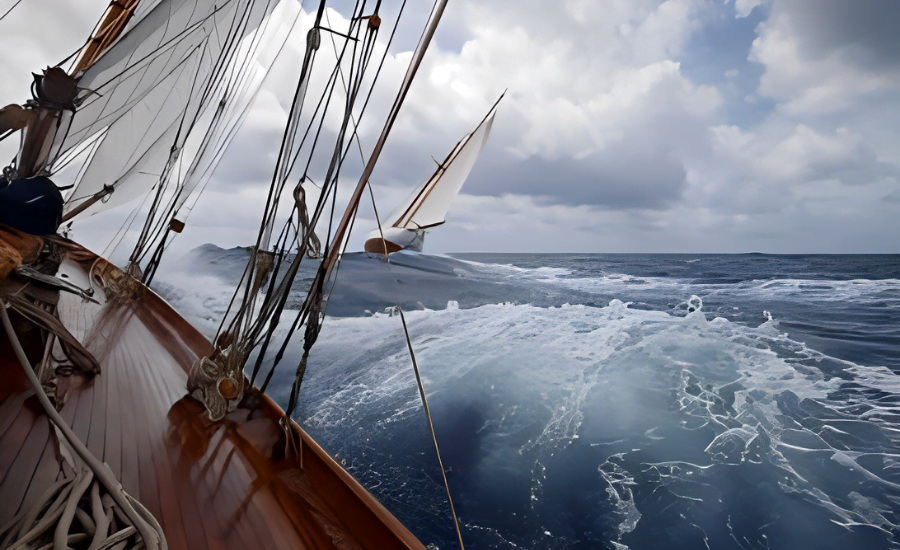
Navigating a ship on the open sea is a complex task in which the environment is strongly influenced by wind and ocean currents. Understanding the complex effects of wind and currents on vessel maneuvering is critical for mariners who want to ensure the safety and precision of their vessels. Let’s start by taking a closer look at the gradual effect of wind and currents on boat handling.
Step 1: Understand the Effects of Wind Strength and Direction
Force Coefficient
The force exerted on a ship by the wind is proportional to the speed of the ship and the exposed surface. This force can be calculated using the following formula: Force = 0.
5 * ρ * A * V^2, where ρ is the air density, A is the cross-sectional area exposed to the wind, and V is the wind speed.
Effect of Direction
The direction in which the wind blows is a determining factor. Widespread winds can cause lateral movement, and headwinds or tailwinds have a significant effect.
Step 2: Effects on Ship Motion Lateral Drift
Leeway Effect
The effect of wind blowing against the side of the ship creates a lateral drift or leeway. The amount of clearance is influenced by factors such as hull design, wind strength, and ship speed.
Compensatory Measures
Ship management techniques, such as the use of the ship’s rudder, engine, or a combination of both, are used to counteract slack and maintain the desired course.
Turning and Maneuvering
Wind Turning
Strong winds against the side of the ship can cause unintended turns. This turning effect is known as the “weather rudder” or “leeward rudder” and must be anticipated and managed by navigators during maneuvers, especially in confined spaces or narrow channels.
Step 3: Analyze the Effects of Flow Water Flow and Velocity
Current Strength
Water current exerts a force on the ship’s hull, affecting its speed and course. The force exerted by the current can be calculated similarly to wind force, taking into account the density of the water, the area of the vessel’s water interruption, and the speed of the flow.
Variable flows
Flows can vary in strength and direction depending on factors such as tides, geographic features, and local conditions.
Margin and Drift Correction
Combined Effect
The interaction of wind and current increases the lateral forces acting on the ship through the effect of wind. Navigators must continually adjust the ship’s course and speed to compensate for slack caused by effect of wind and currents.
Step 4: Challenges in Port Operations Docking and Berthing
Wind Drifting
Effect of wind can be a challenge during berthing maneuvers and can cause ships to veer off course. When approaching a dock or berth, mariners consider the effect of wind on the vessel’s drift
Tugboat Support
Tugboats used to control vessel movements and ensure safe and accurate berthing operations, especially under difficult wind conditions.
Narrow Canals and Bridges
Wind Effects in Narrow Areas
Navigating under narrow canals and bridges in windy conditions requires heightened caution. Accurate navigation is important as the effect of wind can be significant in confined spaces.
Communication and Planning
Effective communication between bridge teams and cooperation with port management is essential for safe crossings. To avoid accidents, it is important to plan for possible wind effects early.
Step 5: Advanced Ship Management Technologies Predictive Modeling and Simulation
Technological Solutions
Advanced navigation systems use predictive models to predict the effects of wind and currents on ships. These systems integrate real-time weather data and vessel characteristics to provide forecasts and simulations to navigators.
Simulation Training
Seafarers undergo simulation training to improve their skills in handling ships in various environmental conditions such as wind and currents. Simulators recreate realistic scenarios and provide hands-on experience in a controlled environment.
Dynamic Positioning Systems
Automated Solutions
Some vessels use dynamic positioning, which uses thrusters and other techniques to maintain position, heading, and stability without traditional anchoring. Using the system. These systems automatically adjust the ship’s position based on environmental conditions such as wind and ocean currents.
Step 6: Continuous Monitoring and Adjustment Real-time Monitoring
Navigation Instruments: Continuous monitoring of navigation instruments, weather forecasts, and real-time data is essential to adapt to changing wind and tidal conditions. Is. Anemometers, flow meters, and GPS are important tools for real-time assessment.
Bridge Team Communication
Open communication within the bridge team ensures that everyone is aware of current environmental issues. Regular updates on the effect of wind and current conditions enable collaborative decision-making.
Course Adjustment
Dynamic Planning
Sailors dynamically adjust course, speed, and engine power based on continuous assessment of the wind and current conditions. Adaptive planning is essential to maintaining safe and efficient navigation.
Adaptability
The ability to adapt quickly to changing circumstances is a hallmark of an effective captain. Sailors rely on experience and judgment to make timely decisions in response to the dynamic interaction of wind and current.

Conclusion
Navigating a Ship Handling through winds and currents requires a multifaceted approach that combines experience, skill, and a deep understanding of complex interactions. Equipped with the knowledge and technical tools, seafarers overcome the challenges posed by wind and ocean currents and demonstrate their seafaring artistry in a variety of marine environments. Continuous adaptation to environmental influences highlights the dynamics of Ship Handling and highlights the importance of well-trained and responsive bridge teams in ensuring the safety and efficiency of maritime operations.









